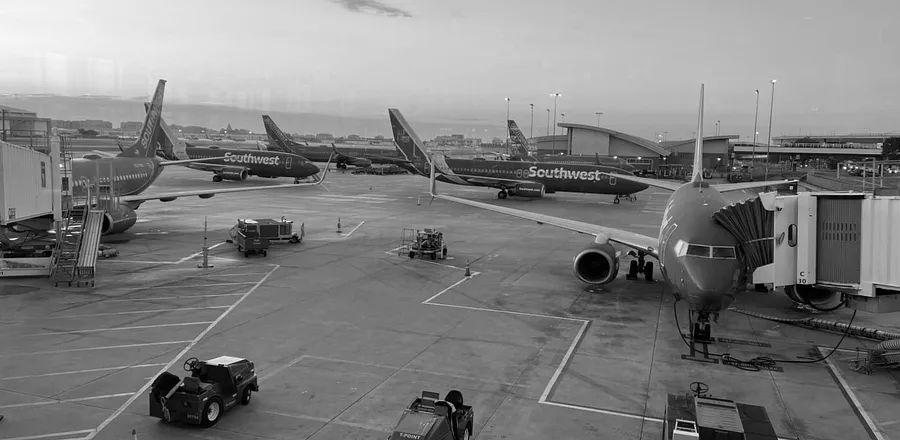What's Wrong with U.S. Flight Technology?

Southwest Airlines’ operational collapse, which extended last month's travel disaster, along with the FAA computer outage that grounded flights nationwide in January, is raising new concerns about the persistent issues in U.S. aviation infrastructure.
Despite airlines promising short-term solutions like adding staff to manage the post-pandemic travel surge, the deeper issue remains unresolved—outdated and glitchy technology.
William McGee, senior fellow at the American Economic Liberties Project and author of Attention All Passengers, criticizes both the government and airlines for neglecting essential tech upgrades. He cites last summer’s travel chaos, where over 100,000 flights were disrupted due to operational and staffing shortages, as proof of this ongoing failure.
Though many factors, like weather, contribute to flight delays and cancellations, McGee argues the aviation system is more prone to extended disruptions because it’s constantly pushed beyond its capacity.
The latest disruptions have brought to light a persistent issue: both Southwest Airlines, the largest domestic carrier, and the national air traffic control system have been hindered by insufficient investment in essential technology.
Recently, much of the criticism has been directed at Southwest Airlines, recognized as the leading airline in the U.S. based on domestic passenger numbers. In the past, singling out Southwest would have been unthinkable due to its strong brand image and customer-friendly policies, such as allowing free checked bags and having generally upbeat crew members.
This time, even Wall Street analysts were critical of the airline. “Every U.S. airline struggled during Christmas,” notes Helane Becker, an analyst at Cowen. “However, Southwest performed the worst among them.”
During a wave of delays and cancellations caused by severe winter storms coinciding with the holiday rush, all airlines faced overwhelmed call centers and excessively long wait times. However, Southwest's internal operations particularly faltered. Becker points out that active-duty crew members struggled to contact the airline for their next flight assignments amidst the chaos.
In total, Southwest canceled approximately 17,000 flights during the holiday season, impacting over 2 million travelers.
Southwest allocates $1 billion for technology upgrades
Following multiple customer apologies and a promise to compensate affected travelers and increase staffing, Southwest CEO Bob Jordan addressed the airline's technological shortcomings last week.
In an email sent to members of Southwest’s Rapid Rewards loyalty program, Jordan announced that the airline would accelerate its technology enhancements, dedicating around $1 billion for IT system upgrades. Additionally, the airline is enlisting the reputable Oliver Wyman aviation consulting firm to assess the issues and suggest further solutions. A Southwest spokesperson stated to Dinogo that tech upgrades are already underway, noting that they have gained valuable insights from the December incidents to avoid future disruptions. The airline is anticipated to detail some of these advancements when it releases its fourth-quarter financial results later this week.
However, some industry experts express skepticism, pointing out that Southwest has traditionally approached things differently from its competitors.
Brett Snyder, an airline expert who operates the website Cranky Flier, remarks that for years, Southwest believed its system was adequate—thinking, 'We’re a simple airline and will adapt as needed.' Instead of pursuing a complete overhaul, the airline opted to make do with its existing system, essentially patching together various solutions.
Another aspect of their simplicity—the airline’s primarily point-to-point route network—is challenging to manage during nationwide weather events, a situation exacerbated by the airline's outdated information technology for both crew and passengers,” states Joe Brancatelli, who operates the business travel site JoeSentMe. Unlike the hub-and-spoke systems of major airlines that channel passengers through large hubs like Atlanta and Dallas/Fort Worth, the point-to-point model focuses on more frequent short flights between smaller markets. The drawback is that this can leave crews stranded in the wrong locations, without available aircraft,” commented Captain Mike Santoro, vice president of the Southwest Airlines Pilots Association, told CNN.
What is NOTAM and why did it fail?
Another outdated technology system is the FAA’s, which faced scrutiny following a computer crash on January 11. This incident resulted in a near-total shutdown of U.S. airspace for the first time since the September 11 attacks in 2001. The issue arose from the agency's “Notice to Air Missions” (NOTAM) system, responsible for sending essential safety alerts to pilots regarding runway closures and airspace restrictions due to military activities. Although the grounding was brief, it led to over 11,000 flights being delayed or canceled. An FAA investigation revealed that the problem stemmed from a contractor who mistakenly deleted files during a system upgrade.
However, this incident highlighted the FAA’s sluggish progress in transitioning its air traffic control from radar-based to satellite-based systems. The long-delayed Next Gen project has been under discussion for over 20 years, prompting insiders to jokingly suggest it should be named ‘Last Gen,’” notes McGee. A 2021 report from the Department of Transportation’s Inspector General criticized the agency for its slow modernization efforts.
In the meantime, both Congress members and the Transportation Department are committed to uncovering the causes of the air travel chaos—to prevent future occurrences. While the recent operational failures may raise concerns among travelers about the reliability of future flights, one potential positive outcome of these significant technology issues and their resulting disruptions is that they can no longer be ignored.
Evaluation :
5/5



